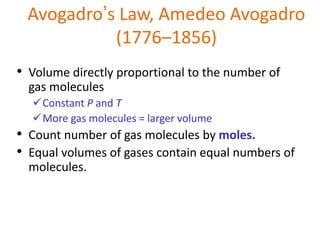
Avogadros law and Ideal Gas Law.ppt
- 1. Avogadro’s Law, Amedeo Avogadro (1776–1856) • Volume directly proportional to the number of gas molecules Constant P and T More gas molecules = larger volume • Count number of gas molecules by moles. • Equal volumes of gases contain equal numbers of molecules.
- 2. Avogadro’s Law The volume of a gas sample increases linearly with the number of moles of gas in the sample. When the amount of gas in a sample increases at constant temperature and pressure, its volume increases in direct proportion because the greater number of gas particles fill more space.
- 3. Avogadro’s Principle • Equal volumes of gases contain equal numbers of moles at constant temp & pressure true for any ideal gas V n V1 n1 = V2 n2
- 4. Sample Problem: What will be the final volume of a 5.0L He gas which contains 0.965mole at 30°C and 1 atm, if the amount of this gas is increased to 1.80 moles provided that temperature and pressure remains unchanged?
- 5. Answer the following: 1. A 7.25L sample of nitrogen gas is determined to contain 0.75 moles of nitrogen. How many moles of nitrogen gas would there be in a 20 L sample provided the temperature and pressure remains the same?
- 6. Answer the following: 2. What will be the final volume of an 8.0 L Helium gas which contains 0.95 mole at 350°C if the amount of gas is increased to 1.75 moles?
- 7. Ideal Gas Law • The relationships that we have discussed so far can be combined into a single law that encompasses all of them.
- 8. Ideal Gas Law By combining the gas laws we can write a general equation. R is called the gas constant. The value of R depends on the units of P and V. We will use and convert P to atm and V to liters. The other gas laws are found in the ideal gas law if two variables are kept constant. The ideal gas law allows us to find one of the variables if we know the other three.
- 9. Ideal Gas Law • UNIVERSAL GAS CONSTANT • R=0.0821 Latm/molK PV = nRT
- 10. Ideal Gas Law
- 11. Sample Problem: • What is the volume of a container that can hold 0.50 mole of gas at 25°C and 1.25 atm?
- 12. Answer the following: 1. Calculate the pressure exerted by a 0.25 mole sulfur hexaflouride in a steel vessel having a capacity of 1250 Ml at 70°C.
- 13. Answer the following: 2. Fermentation of glucose produce gas in the form of carbon dioxide, how many moles of carbon dioxide is produced if 0.78L of carbon dioxide at 20.1°C and 1 atm was collected during the process?